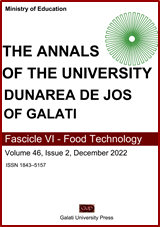The stability of whey protein-stabilized red palm oil emulsion from a rheological perspective
Abstract
The objective of this study was to investigate into the physical stability of whey protein (WP)-stabilized red palm oil (RPO) emulsions based on rheological properties such flow behaviour, viscoelastic properties, apparent viscosity (ηapp), and linear viscoelastic range limits (LVE). RPO emulsification was stabilized by three types WP with different protein content, notably WPI90, WPC80, and WPC76, and the influence of WP type and concentration (2.5-15%) was evaluated. Utilizing the type and concentration of WP used, RPO emulsions with good apparent thermodynamic stability could be formed. All of the emulsions showed shear-thinning flow behaviour with viscous properties (G" >> G′). However, as a result of the different WP types and concentrations utilized, the emulsions produced had varied kinetic stability and rheological properties. Droplet characteristics, such as D10, D50, and D90, ζ potential, and electrical conductivity were determined, and rheological data gained corresponded with these properties to explain emulsion stability. The LVE value reflected the stability of the produced emulsions as well as the ηapp difference. The emulsion stabilized with 15% of WPC76 had optimum physical stability in this study, with an LVE of 7.9%. This study demonstrate that rheological characterization can be employed to assess the stability of WP-stabilized RPO emulsions.


